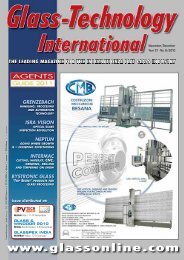VITRUM ENERGIA - Artenergy Publishing
VITRUM ENERGIA - Artenergy Publishing
VITRUM ENERGIA - Artenergy Publishing
Create successful ePaper yourself
Turn your PDF publications into a flip-book with our unique Google optimized e-Paper software.
100<br />
Bystronic glass:<br />
reduced costs of PV<br />
module production<br />
the TPS ® unit against moisture from outside.<br />
These properties are also needed in the PV industry.<br />
Moisture can attack the photovoltaic active<br />
layer which impacts module efficiency and<br />
which could result in delaminating and corrosion<br />
of the module. Therefore TPS ® is well suited to<br />
seal any thin film module, either with or without<br />
foil. If the module has a foil, the TPS ®<br />
material is applied before the lamination process<br />
starts. For this purpose Bystronic glass has<br />
transferred the application process for the TPS ®<br />
sealant material to the horizontal design.<br />
This new horizontal TPS ® applicator (photovoltaic<br />
TPA) is embedded in the PV production<br />
process prior to the lamination station. The substrate<br />
glass is transported via conveyer to the<br />
photovoltaic TPA, where it is automatically<br />
positioned. The machine then applies a very thin<br />
and accurate TPS ® sealant bead. The accuracy is<br />
better than 5/100 millimetres, which is essential<br />
for the following lamination process.<br />
Second option: sealing modules using TPS ®<br />
multilayer application<br />
The other way to seal PV thin film modules<br />
with TPS ® is on specially designed units. In this<br />
case, the lamination foil is not used, but for security<br />
reasons the PV module needs toughened glass.<br />
TPS ®<br />
multilayer<br />
application<br />
Glass-Technology International 2/2010<br />
w w w . g l a s s o n l i n e . c o m<br />
Application of<br />
a very thin<br />
sealant bead<br />
The encapsulation process for this kind of module<br />
is very similar to the insulating glass production<br />
process. The main difference compared to the<br />
TPS ® insulating glass production process is the<br />
application of two sealant beads. The reason for<br />
this is very simple. Between the first and the<br />
second layer, the contacts are put through the<br />
sealant. The contacts are therefore protected by<br />
the sealant and the unit remains tight.<br />
Main advantages of the TPS ® multilayer<br />
encapsulation<br />
The traditional encapsulation of glass-glass<br />
PV modules is carried out by lamination foil<br />
such as EVA or PVB-foil. And one of the last<br />
manufacturing steps in the encapsulation is the<br />
glass and foil lamination in a vacuum or in a<br />
roller laminator. The TPS ® multilayer system<br />
now gives manufacturers the possibility to produce<br />
a module between 30 and 50 seconds, without<br />
a batch process. The cost reduction factor provides<br />
a strong case for the TPS ® multilayer system,<br />
not only in respect of the cycle time, but<br />
also with the abolition of the lamination foil. For<br />
BIPV manufacturers, the TPS ® multilayer system<br />
provides many variations for the manufacture of<br />
PV panels, especially when the dimensions of the<br />
modules become larger from year to year.<br />
There are a lot of advantages for the TPS ®<br />
encapsulation process without foil lamination:<br />
• the cycle time is down to less than 30 seconds<br />
for one module;







